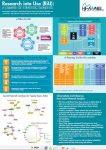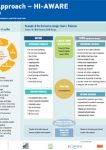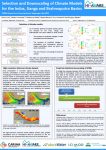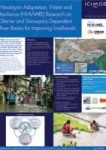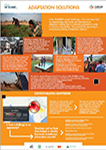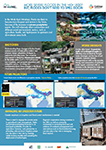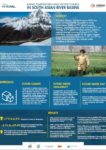Pilot Approach – HI-AWARE
Poster , 2016
Testing a specific technology, measure, approach, or innovation in a real life situation in close interaction with stakeholders, to test if they work before going to scale.
Gendered Vulnerability in the Climate Change Context
Poster , 2016
Gender and gendered differences are socially constructed, reflecting the situated social and cultural norms at a particular spatial and temporal juncture. These constructions are not constant but erformative; unstable and changing over time to reflect evolving realities.
Eco-San Toilet in North Bihar
Poster , 2016
An odorless and integrated sanitation method for individual households, the eco-san has been regarded as a blessing for the people of North Bihar. Without the need for flushing, it saves water and protects groundwater from contamination. A constant access to sanitation even during floods, thereby providing hygiene and privacy especially for the women- the eco-san is helping in the resilience of the vulnerable population of Northern Bihar. It also provides for agriculture and kitchen gardens manure.
Selection and Downscaling of Climate Models for the Indus, Ganga and Brahmaputra Basins
Poster , 2016
Most precipitationin mountain regions occurs at high altitude. However, precipitation is hardly measured at high altitude because most gauges are installed in the valleys.
HI-AWARE Research on Glacier and Snowpack Dependent River Basins for Improving Livelihoods
Poster , 2015
HI-AWARE, one of four consortia of the Collaborative Adaptation Research Initiative in Africa and Asia (CARIAA),is conducting high-calibre research and pilot activities, capacity building, and policy engagement on climate resilience and adaptation in the mountains and flood plains of the Indus, Ganges, and Brahmaputra river basins.
Adaptation Solutions
Poster 2018
Under HI-AWARE’s project landscape, a focus has been laid on understanding what works and what doesn’t as adaptation solutions from a community perspective in order to minimize vulnerabilities. This provided the opportunity to conceptualize piloting of adaptation solutions.
Critical Moments
Poster 2018
Critical climate-stress moments’ are defined as those moments when households, communities, and the livelihood systems they depend on are especially vulnerable to climate and weather-related risks and hazards
More Severe Floods in the HKH Likely to but, Floods don’t Need to Spell Doom
Poster 2018
In the Hindu Kush Himalaya, floods are likely to become more frequent and severe in the future, because of the increase in extreme precipitation events. This will adversely affect communities and different social and economic sectors, such as agriculture, health, and hydropower in upstream and downstream areas both.
Rising Temperatures and Wetter Futures in South Asian River Basins
Poster 2018
The Indus, Ganges, and Brahmaputra (IGB) river basins are exceptionally susceptible to rising temperatures. Under a 1.5°C global warming
scenario, they would warm up by more than 2°C, on average. A 2°C global warming scenario implies a regional average warming of around 2.7°C. The more likely scenarios specific for the region suggest temperature increases of between 3.5°C and 6°C by 2100. Most projections also indicate wetter conditions in the future.
- 1
- 2

